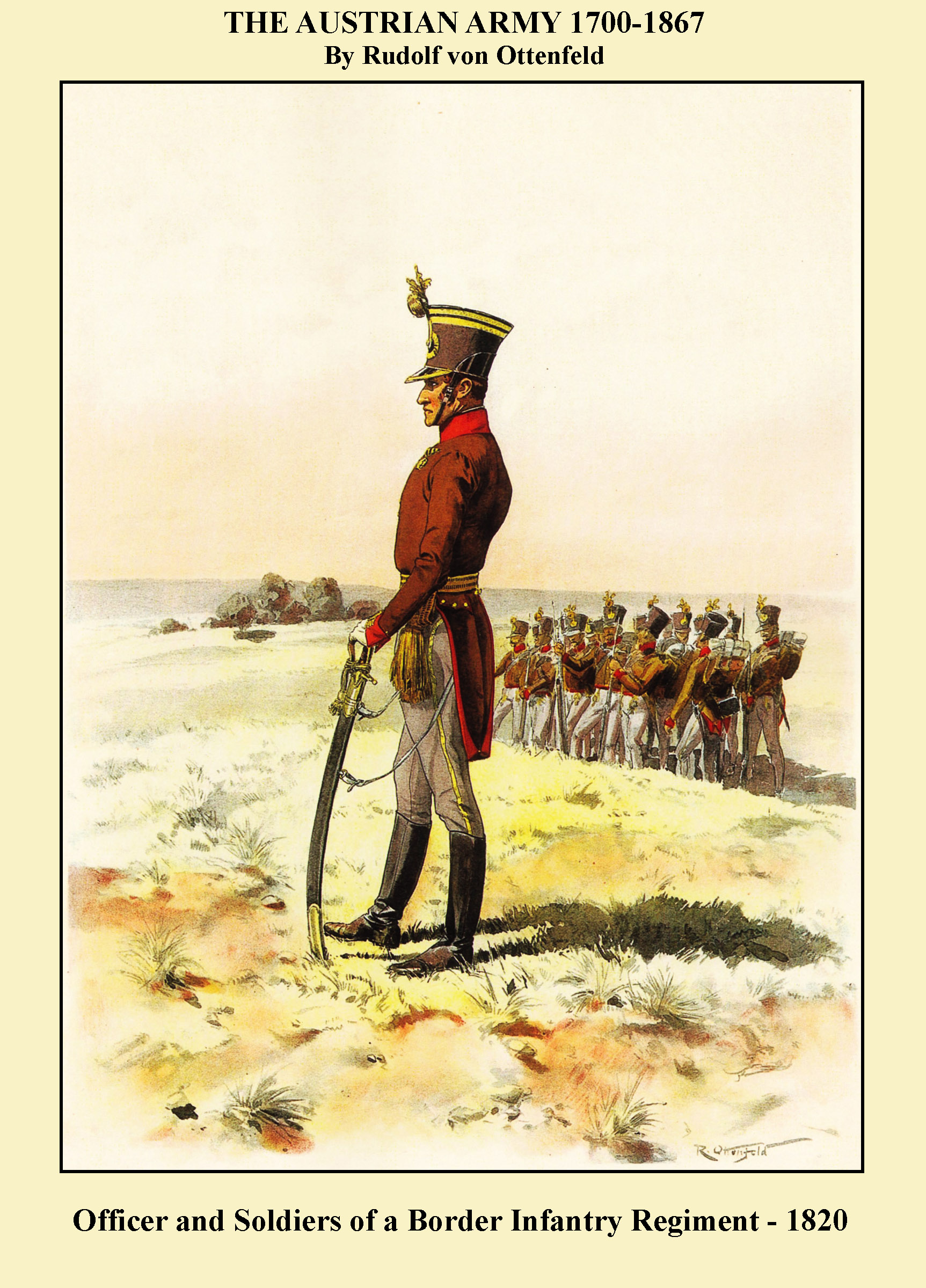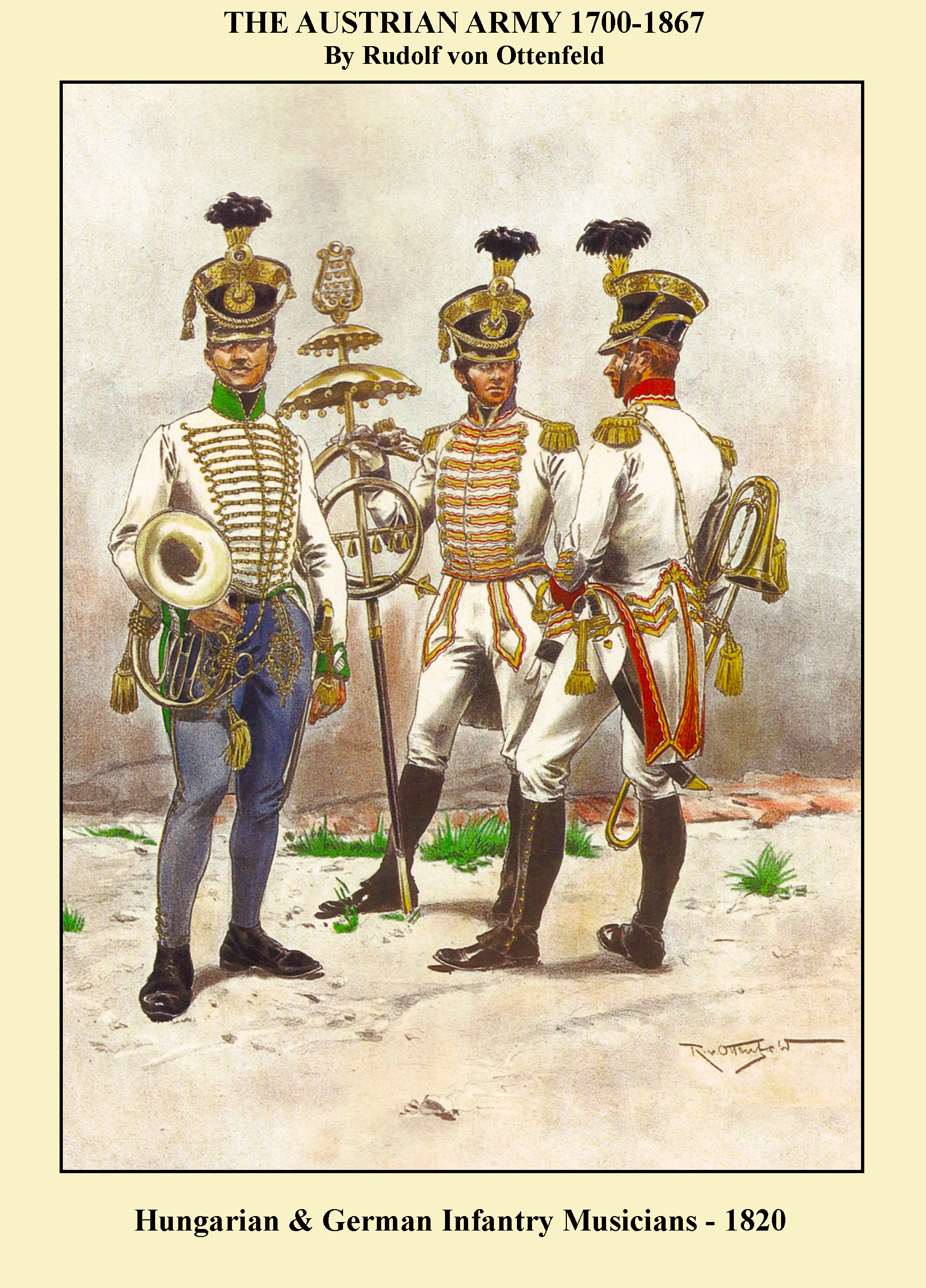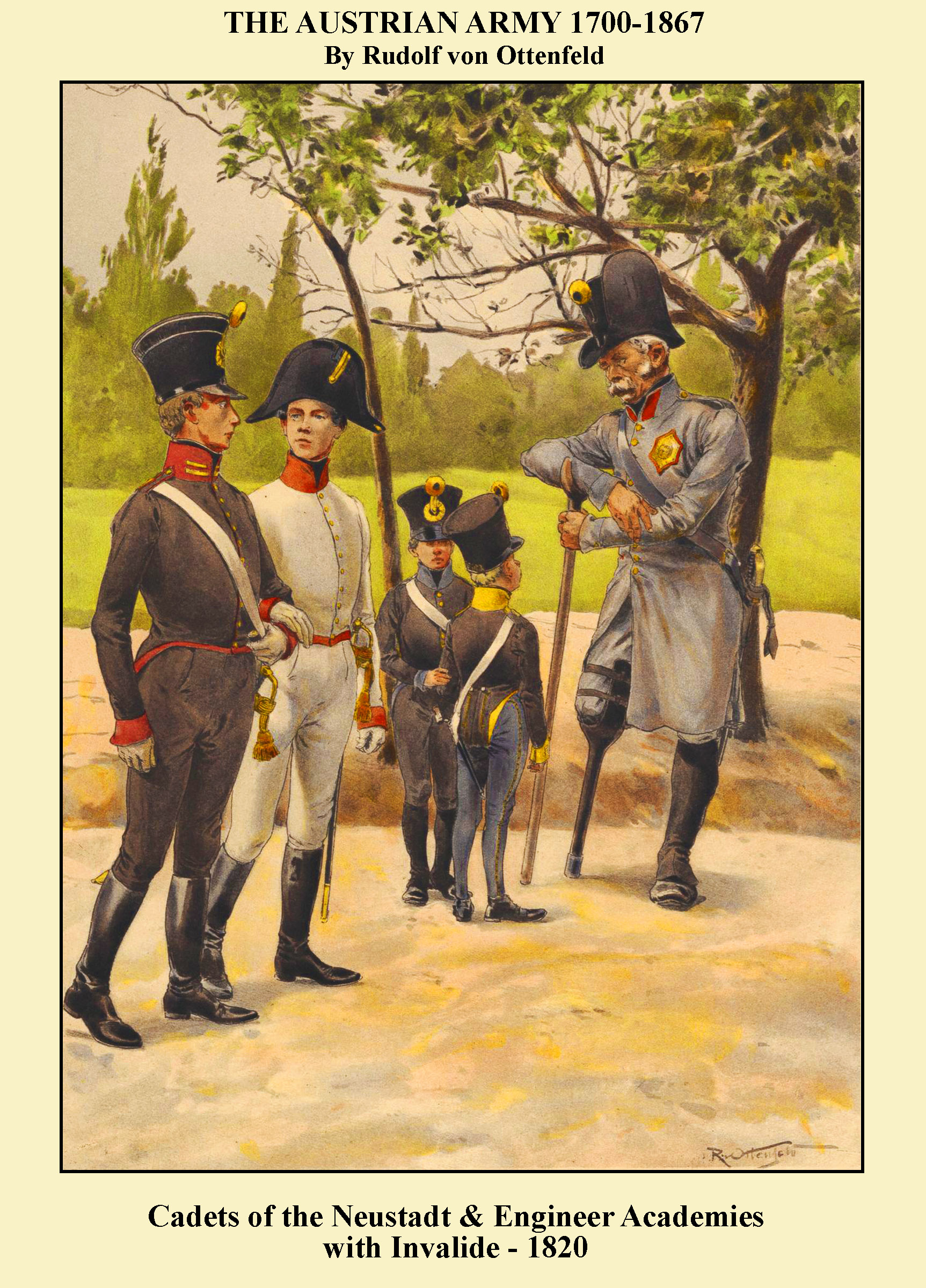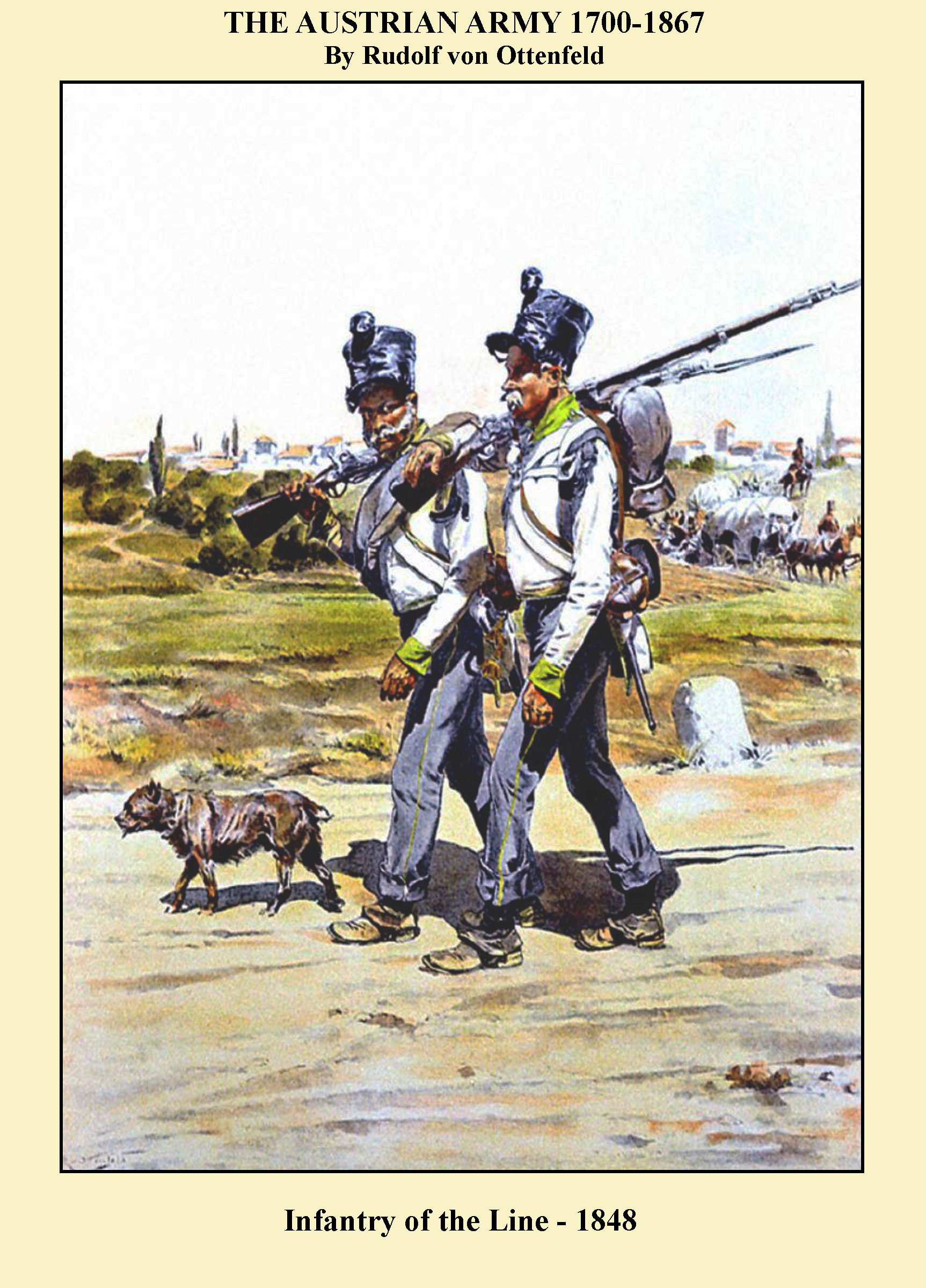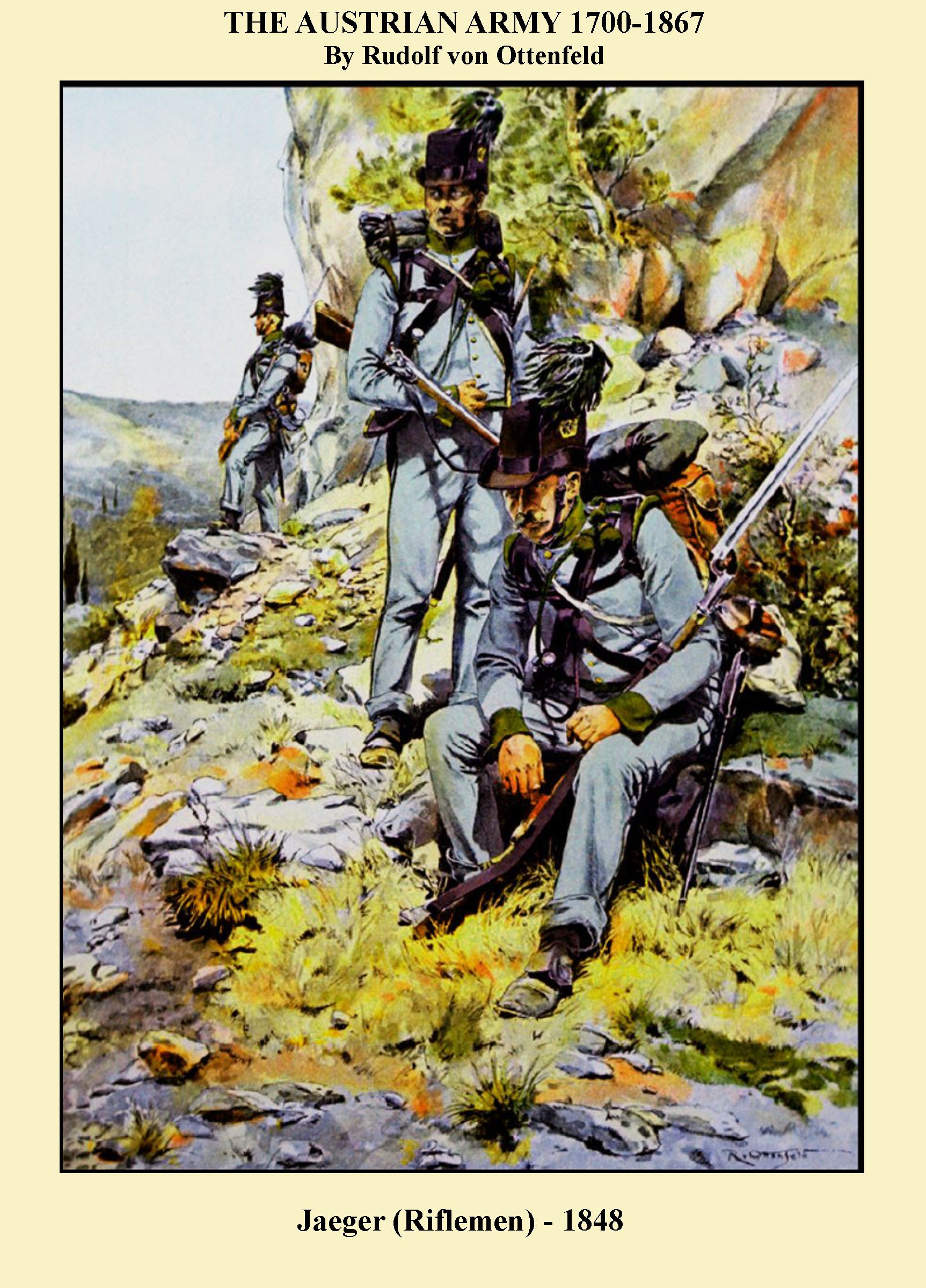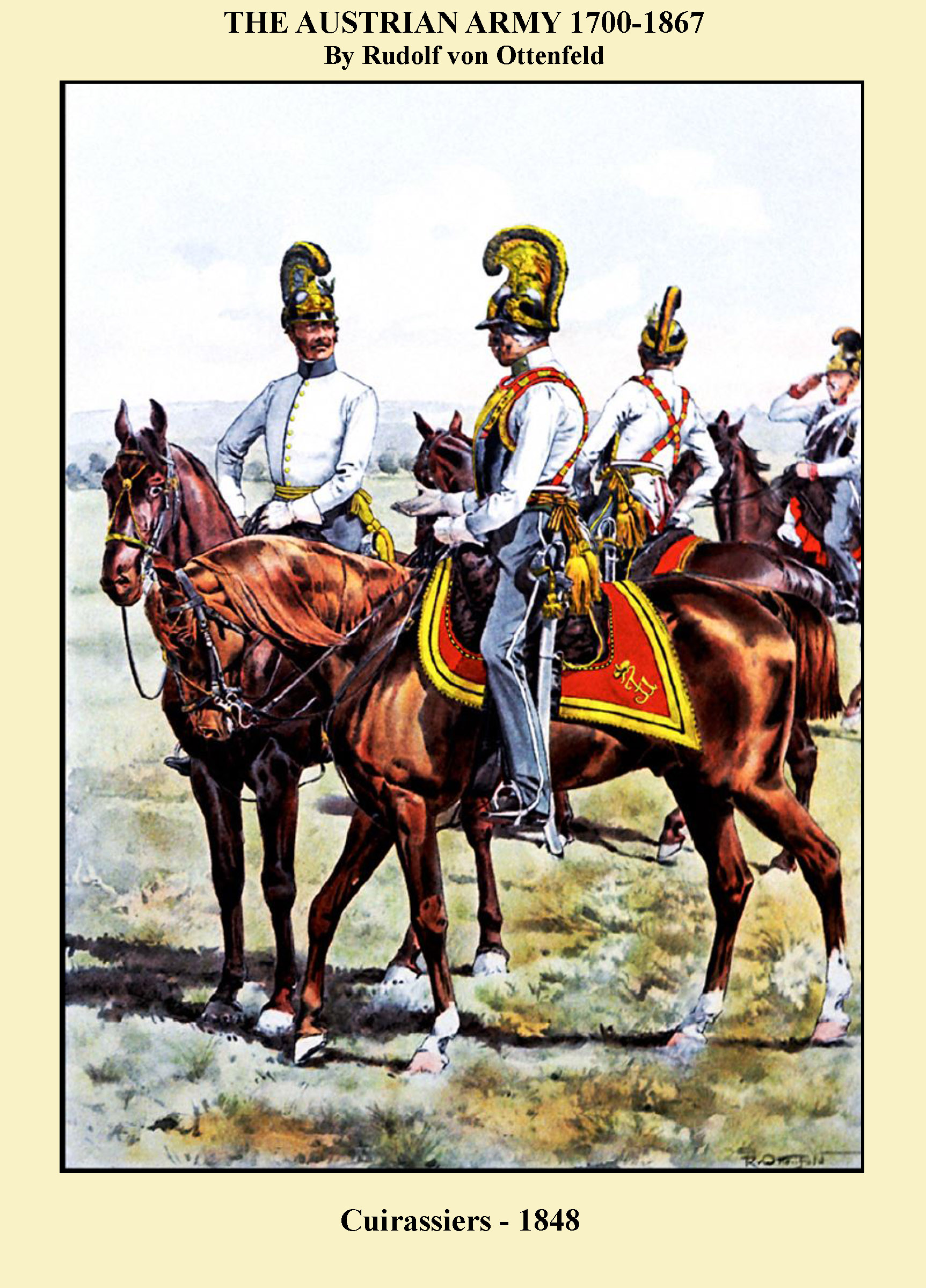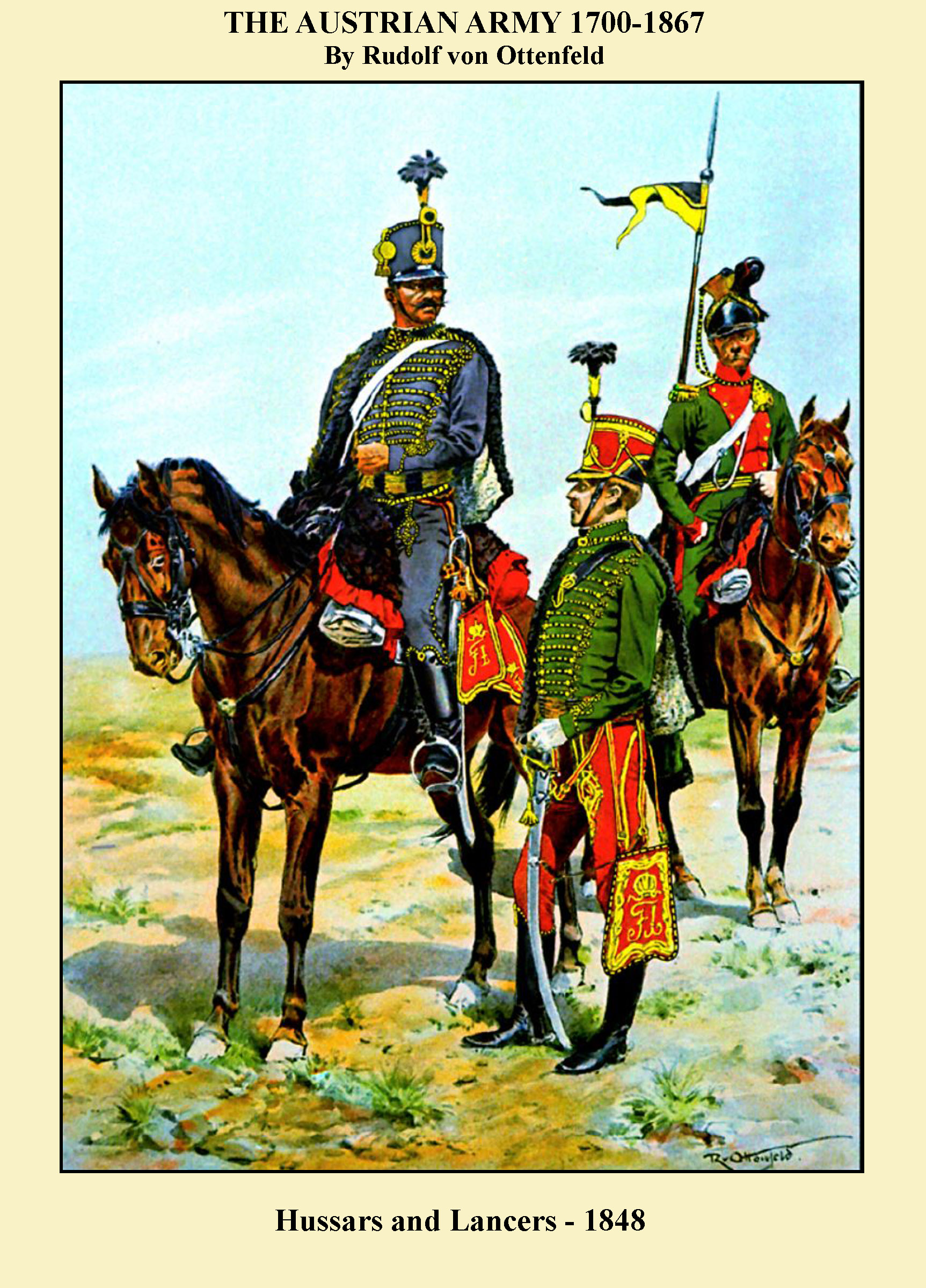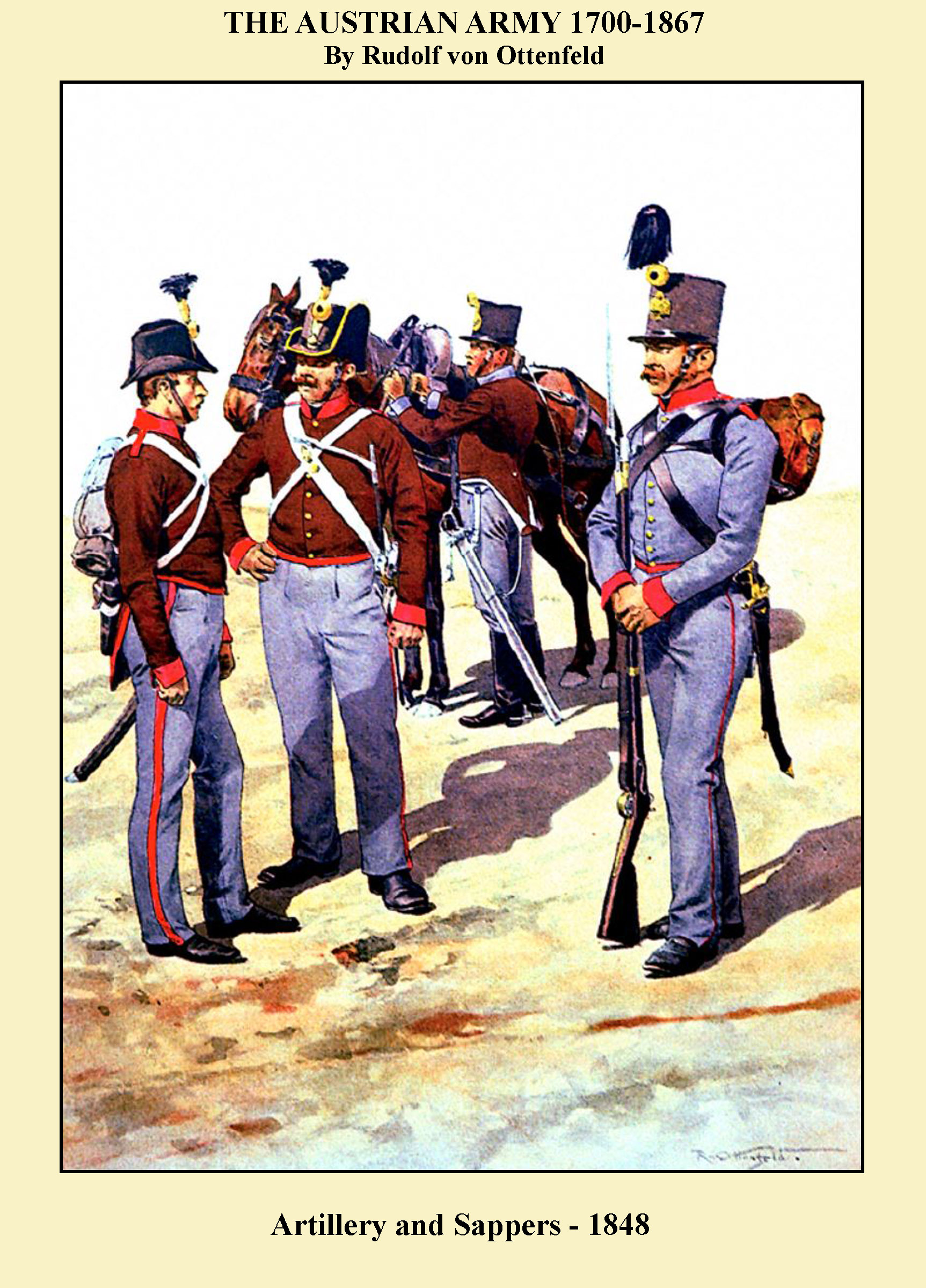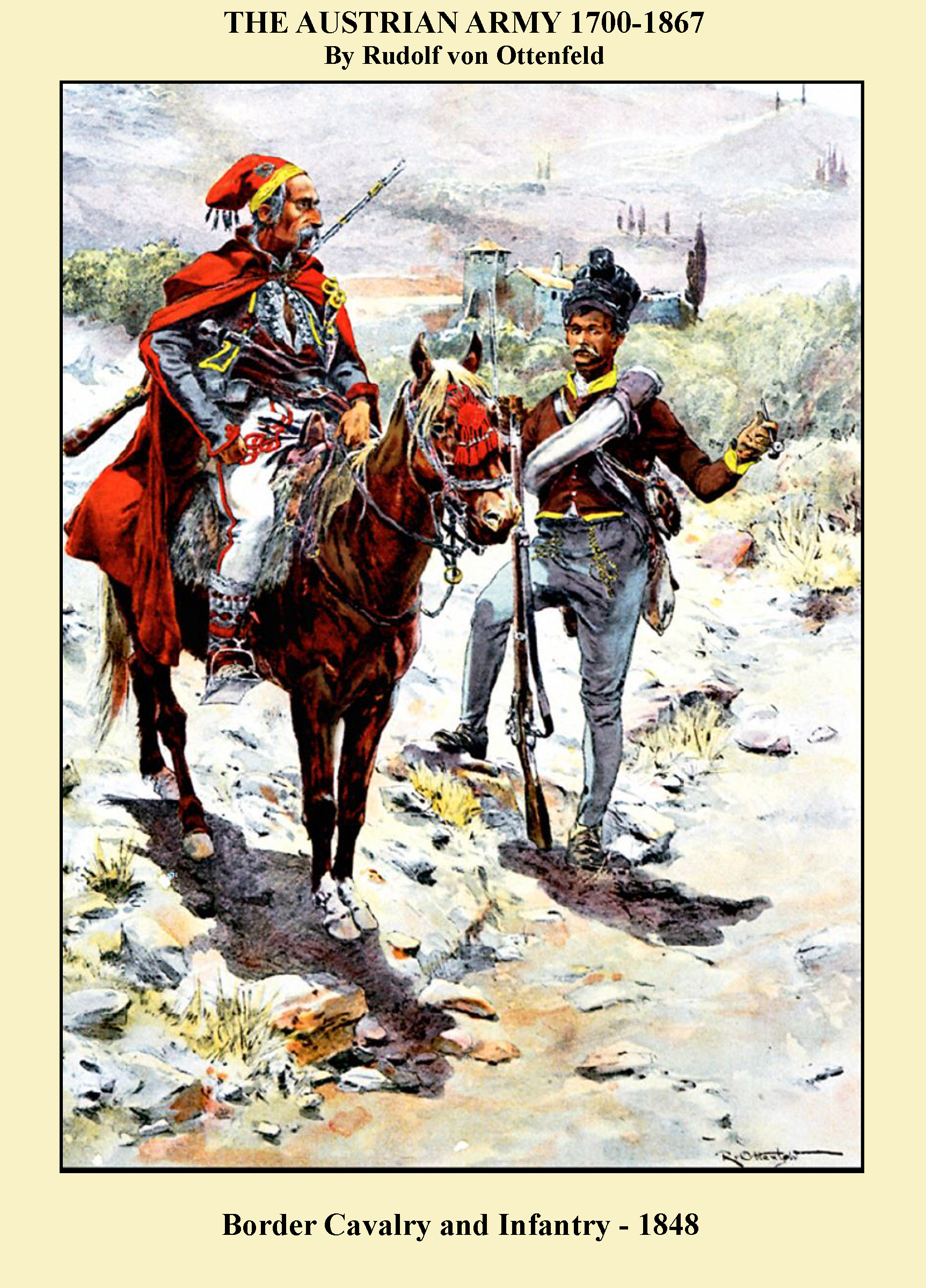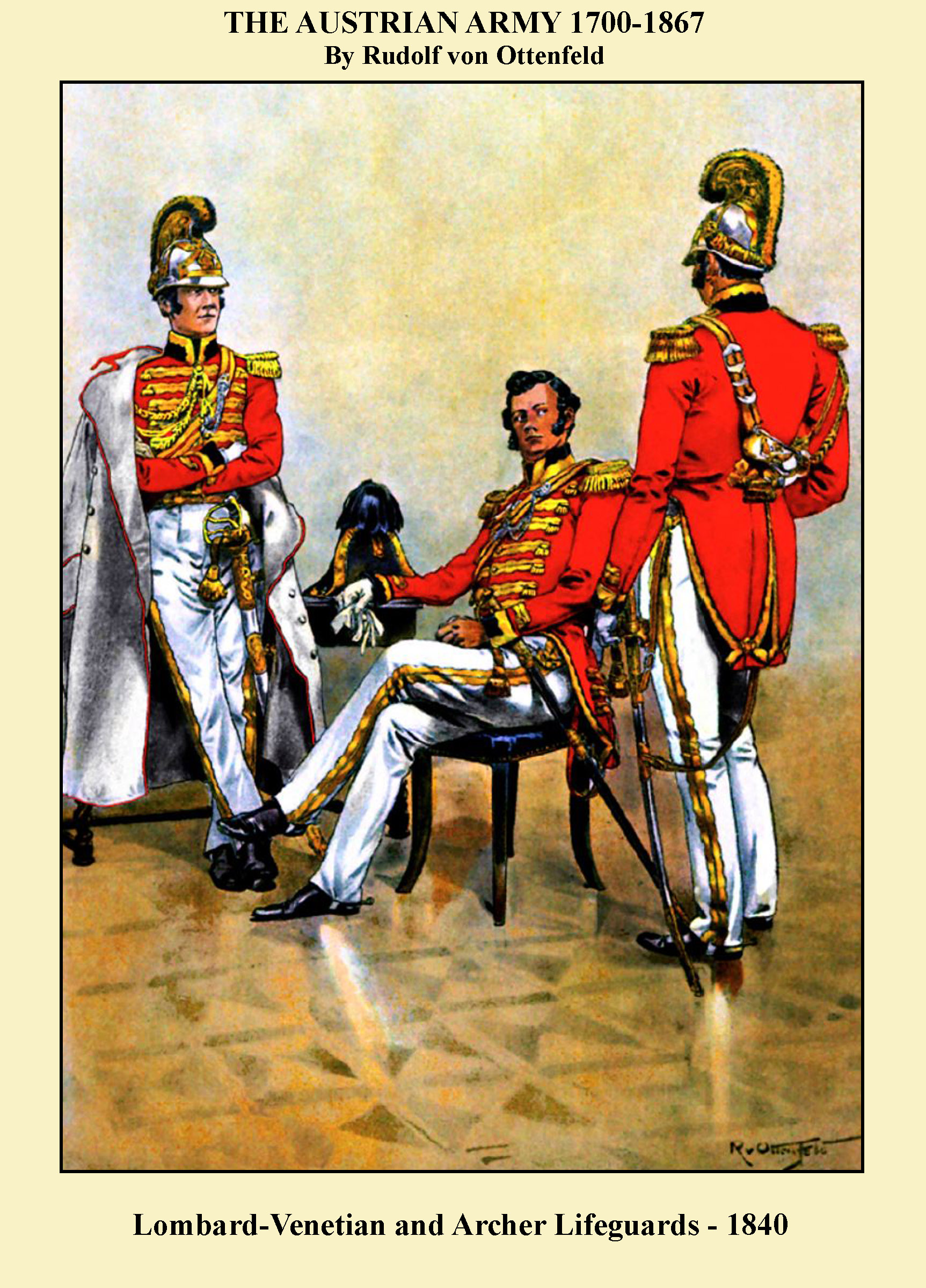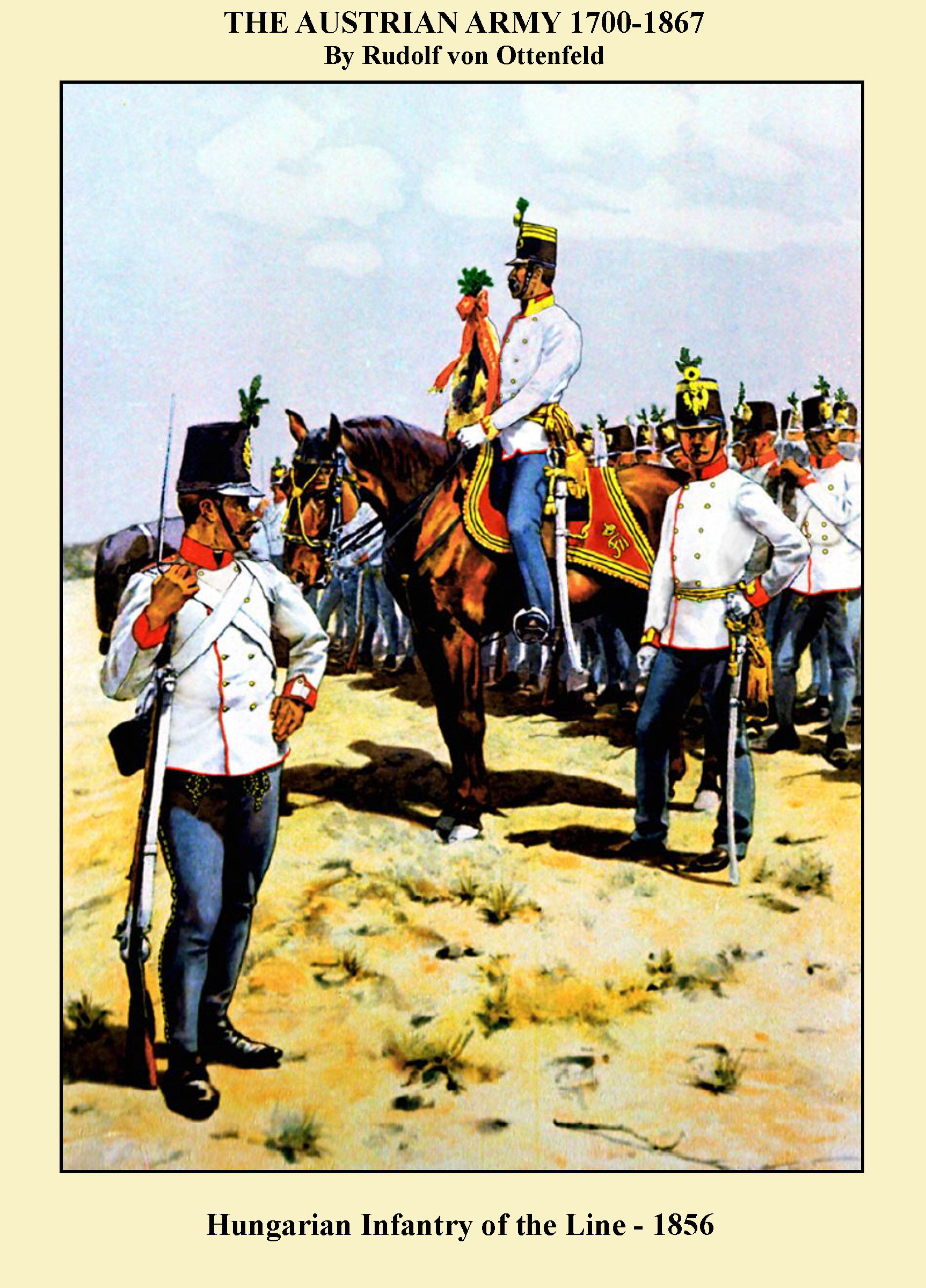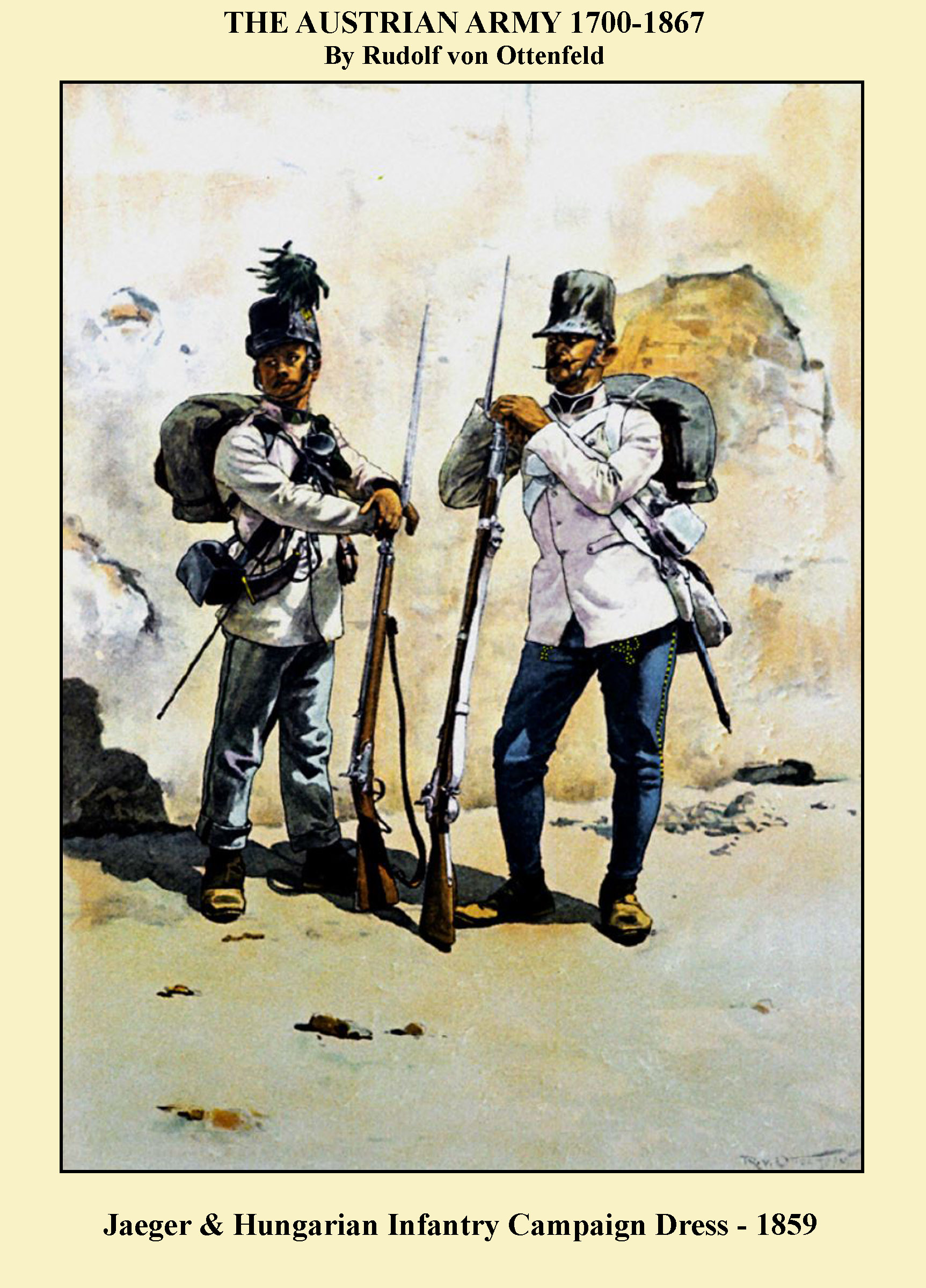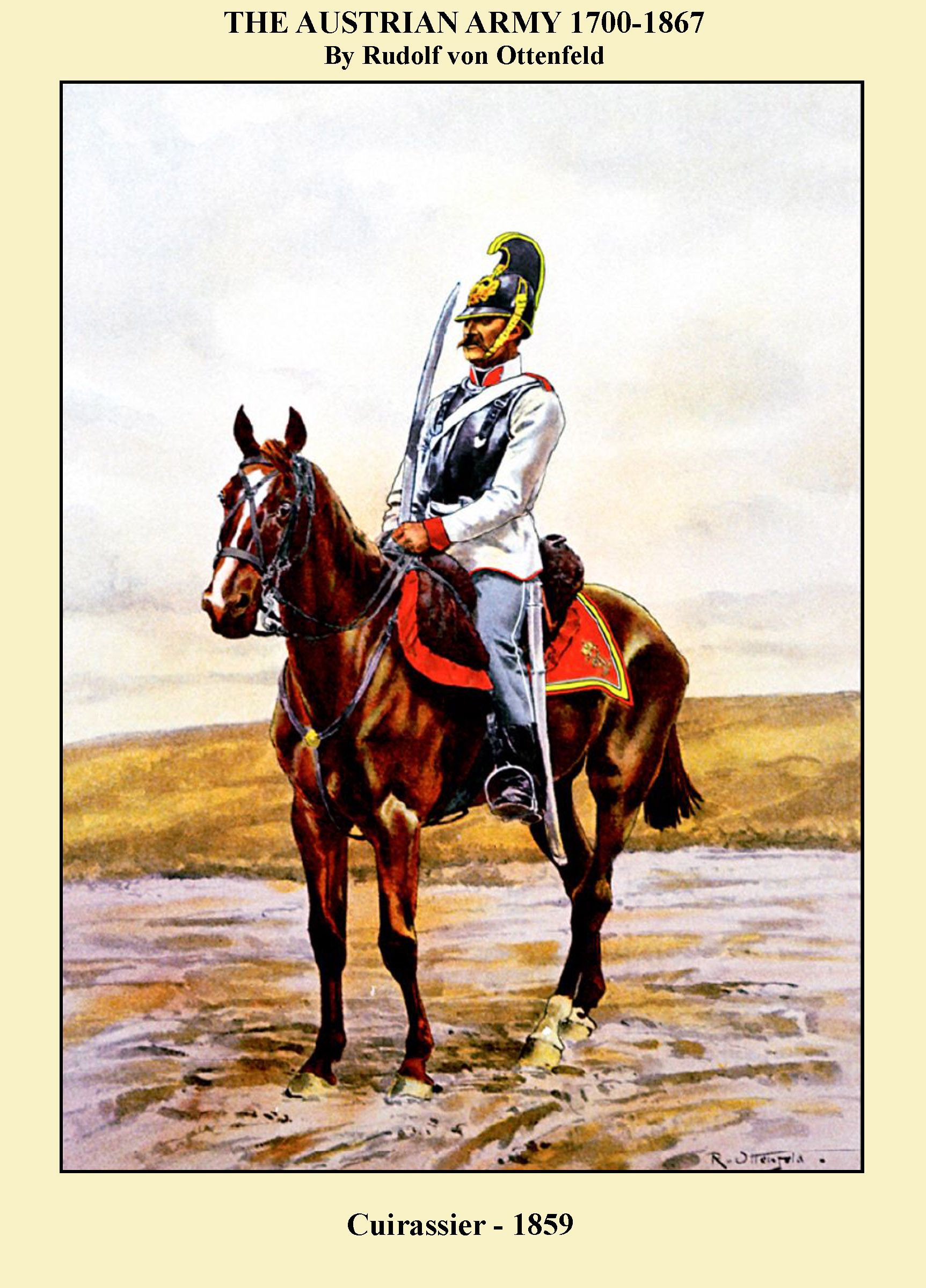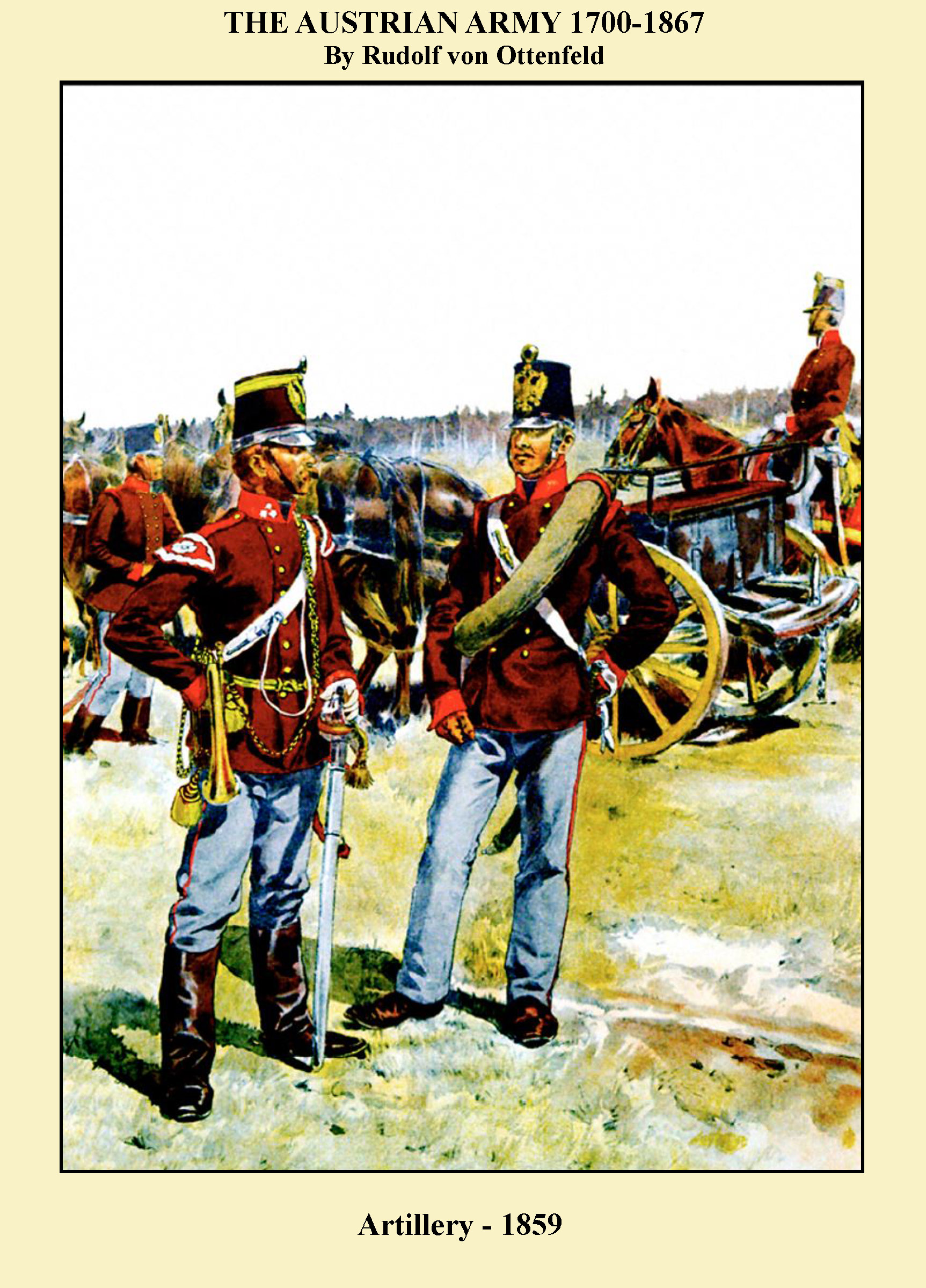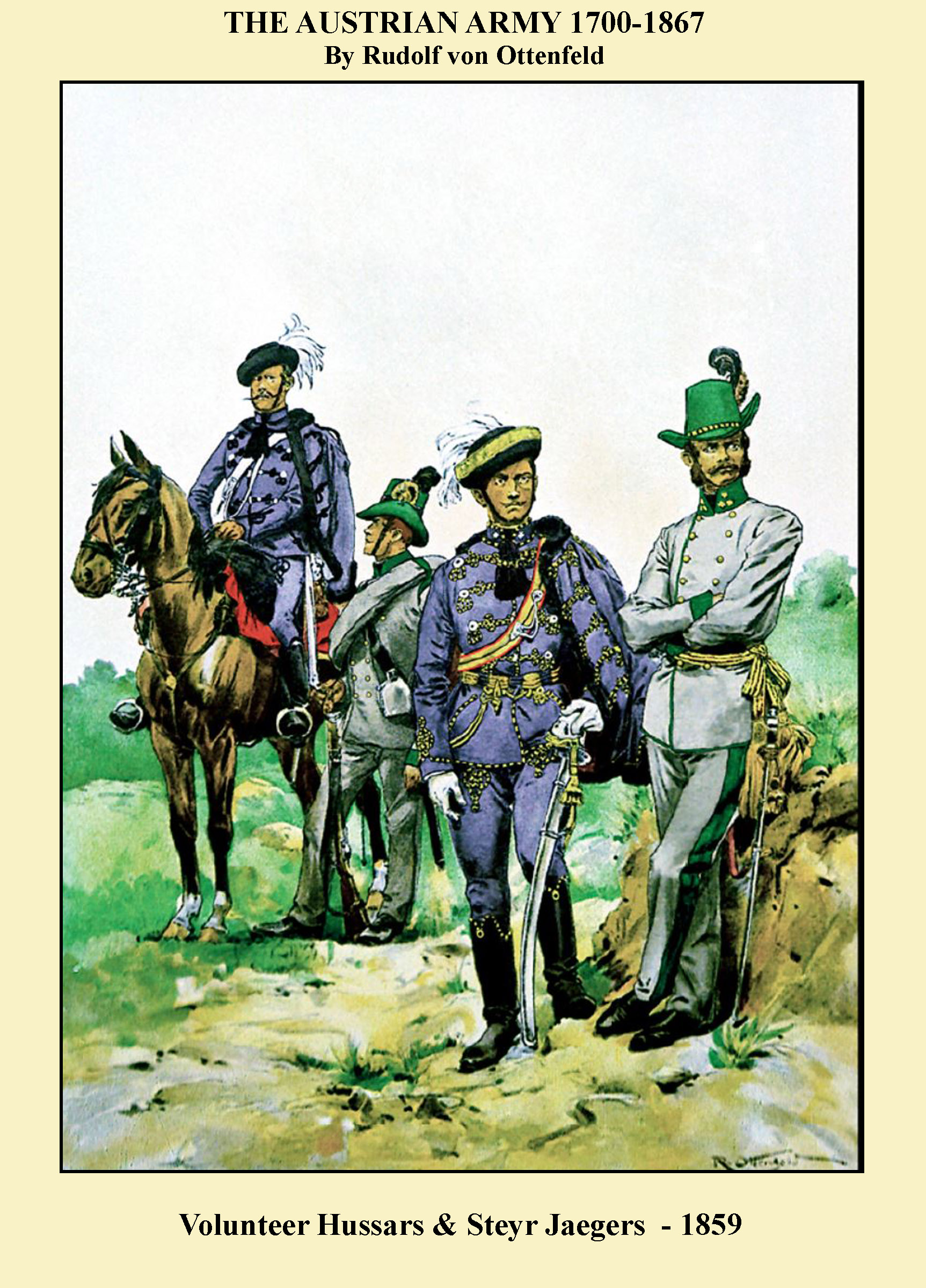THE WORLD OF MILITARY UNIFORMS
1660-1914
THE AUSTRIAN ARMY 1700-1867
By Rudolf Otto von Ottenfeld
Page 5
PART III
THE AUSTRIAN ARMY
1816-1866
From the book by Bruce Bassett-Powell and Philip Cranz published by Uniformology in 2006
The restoration of the pre 1792 status quo in Europe effected by the Congress of Vienna left Austria more powerful than ever. However, the long peace that followed the Napoleonic Wars did little to improve the efficiency of the army despite the fact that it was the most powerful force in central Europe. By 1848 the revolutions in Europe forced the Imperial Family to leave Vienna. The Austrian Army brutally put down the insurrections in Vienna and Prague and under the command of Field Marshall Radetzky defeated the Italians at Custozza. The Hungarian revolution was also suppressed with the help of Russia. Emperor Franz Joseph became Emperor in December 1848 by which time order had been restored.
Despite diplomatic successes in the decade that followed, the Army and its leadership atrophied. When the Italians again made a bid for unification in 1859 with the help of France, the Austrians were defeated in detail at Solferino and lost all of its holdings in Italy except Venice. In 1864 its army initially showed more skill than its Prussian counterparts against the Danes in the 2nd Schleswig War although the Prussian victory at Duppel finally won the war.
The disaster that took place at Koniggratz during the Austro-Prussian War of 1866 finally removed Austria from the helm of central Europe and it remained at the fringes of events until the First World War.
The uniforms of the Austrian Army, illustrated here by Ottenfeld, remained much the same after 1815. Few changes took place until 1848 and more modernizing changes took place in the next 20 years. After its loss in the 1866 War the Austrians were forced to concede a compromise with Hungary and in 1867 the Dual Monarchy of Austria-Hungary began. At that time the white coats worn by the infantry and heavy cavalry were replaced with blue.
Border Infantry 1820
Ottenfeld has seemed to ignore the minor changes in uniform that took place from 1816 to 1836.
However, the officer of Border Infantry here, despite his brown coat and light blue breeches, is dressed as a regular infantry officer would have been in white coatee and breeches. His shako was modified in 1818 to become taller and more bell-topped. The shako for men was also heightened and made more bell-topped retaining its rear peak. It was heightened again in 1827.
Infantry Musicians 1820
The three bandsmen here, like their counterparts in most of Europe, adorned their regular uniforms to stand apart from the rank and file. Regimental commanders had a great deal of licence to dress bandsmen according to their whim. Their shakos are officer’s pattern and their coatees are heavily laced. The French Hornist on the left is from a Hungarian Regiment and the bandsman on the right has an early pattern trombone. The central figure from a German regiment holds a “Glockenspiel” or “Jingling Johnny”.
Academies, Schools and Veterans 1820
Naturally, after a long debilitating war, wounded veterans appeared everywhere for years after. The Austrians treated their veterans better than most of their allies. They were given clothing and a small pension. There were several academies such as the Neustadt for young officers and the Engineer and Artillery schools trained students in technical skills. The uniforms were miniature versions of the regular regiments.
Infantry 1848
These Infantrymen of a German regiment are on the march in Italy during the 1848 campaign. They are wearing the 1837 pattern shako which was lower and more cylindrical than its predecessor and the 1838 pattern trousers. The shakos have oilskin covers. They still appear to have short gaiters underneath the trousers. They carry their equipment in the normal way, the right hand figure with greatcoats atop his valise and the other soldier with it “en banderole”. Ottenfeld shows no grenadiers of this period in his plates. In 1837 the bearskin caps were shortened somewhat and the brass front plate removed. In its stead there was a brass grenade. Although some regiments wore them on campaign in 1848 (usually in oilskin covers) the shorter leather kepi with grenade on the front was more often worn. In any case, the authorities deemed the bearskin too expensive to retain and it was abolished in 1852.
Jägers 1848
The Jägers were the most elite infantry of the Austrian army. They received the best weapons and equipment and unlike the regular infantry were better schooled in marksmanship. They wear the traditional pike gray uniforms with green facings and the “Corsican” hat with one side turned up fastened with a hunting horn ornament. They now wear a green plume. All belts and straps are of black leather. This uniform is nearly identical to the uniform of the Napoleonic era. The picture depicts them during the Italian campaign of 1848.
Dragoons and Cuirassiers 1848
The uniforms of the cuirassiers and dragoons had changed little since the Napoleonic Wars. The cuirassiers always wore only a breastplate of blackened steel. Officers had a gilded “V” shaped panel down the center. The cross belts across the back were of red leather with gilded plates riveted to them to provide some protection from sword cuts. For men, the cross belts were of whitened leather.
Hussars and Lancers 1848
Both hussars and lancer uniforms were, even in 1848, almost completely unchanged since 1815. The hussar’s uniform is laced with black and yellow braid. His pelisse slung over his right shoulder, unlike the French who slung theirs over the left was also of silver gray with black fur trim and the yellow and black cords. The officer’s sabretache is more elaborate than that of the mounted man and his black cartridge box belt has gilded chains and pickers. His red shako is trimmed with gold. Hussar regiments wore uniforms of light blue, dark blue and dark green, the latter with red shakos and breeches. Lancers still wore a dark green uniform with scarlet plastron.
Along with the hussar shako, the czapka was modified and made shorter in 1836
Artillery, Train, and Sappers 1836-1848
While infantry uniforms dating back to the beginning of the 18th Century were white those for the artillery were brown and for the sappers pike gray, like the jägers.
The three artillerymen on the left are distinguished by their brown jackets and blue-grey trousers distinguished with red facings and piping. The artilleryman and bombardier wear the typical Austrian “Corsican” hat. The bombardier, a senior artilleryman like a non-commissioned officer has yellow braid trim on his hat and it bears the Austrian double-headed eagle. He is also distinguished by his cane attached with a strap to his crossbelt. The train driver for artillery has the brown jacket with gray facings and carries the straight cavalry sword. He along with the sapper at right wears the 1836 shako.
The sapper has red facings on his gray uniform and all of his belts and straps are of black leather. At this time the overcoat and bed roll were worn attached to the pack and carried on the back.
Seressaner and Border Infantry 1848
The Seressaners were irregular heavily armed border troops. They were loyal to the emperor who allowed them leeway in both their operations and their dress. They were drawn from the border areas with Italy and were used to combat bandits and to solve local problems. One wonders if they were not merely bandits in the service of the crown. They were quite feared for their ruthless tactics much the same as the Russian cossacks. This figure wears a red cape worn by most Seresaner troops. He carries a musket and brace of pistols along with the quite unique and wicked looking sword thrust though his sash. The Grenz or Border infantry were recruited in the Croation, Ruthenian and Albanian border areas and acted as a type of National guard. They were later formally attached to the army. During this period they were a militia for border protection.
Lombard, Venetian, and Archer Life Guard Officers Ca. 1840
The Austrian Life Guards were ceremonial military units with absolutely no combat role. This painting depicts officers of the Venetian, Lombard, and Archer Life Guards. These men would have been nobles or sons of the wealthy who were chosen for the family status and not for any type of military expertise. The Lombard and Venetian Life Guards were made up of Italians while the Archer Life Guard was a quite old and historical contingent that served the Austrian emperors for hundreds of years. The uniforms of these gentlemen would have been of the best cloth and tailoring with finely embroidered gold lace.
Hungarian Infantry 1856
The Austrian Army adopted the double breasted tunic (Waffenrock) in 1849. It was followed in 1850 by the lower, conical shako or kepi. The uniform colours remained the same for all branches. Illustrated is a Hungarian Infantry Regiment with the typical tight Hungarian style trousers with knots on the thighs and lace down the outer seams of mixed yellow and black cords. Note the “Bears Claw” lace on the cuffs of the officers and men.
Jäger and Infantryman 1859
Both soldiers are shown here wearing the “Kittel”, the short coarse cotton undress jacket of 1850. The facings were only worn on a collar patch. This jacket was extensively worn by all arms during the 1859 war in Italy. The Jäger wears the Corsican hat with the turned up brim and green plumes along with black belts and straps. Note also the unique carriage of the ramrod for the rifle. The infantryman is from a Hungarian regiment. His shako is covered with an oilcloth cover for protection from foul weather. These are the uniforms worn by the Austrian infantry during the Franco-Austrian War of 1859 which secured Italian independence.
Cuirassier 1859
The cuirassier regiments continued to wear the blackened steel breastplate only. The black leather helmet was modified in 1850 with a larger rear peak and the removal of the fur crest with a brass strip. The double breasted jacket is white with red cuffs and small collar patches in the facing color. He carried the short cavalry carbine and a pistol in a holster under the black dyed sheepskin saddle cover. In 1860, Dragoon regiments were converted to Cuirassiers who lost their breastplates at the same time. In 1868, they themselves were converted to Dragoons and Cuirassiers disappeared from the Austrian Army’s order of battle.
Field Artillery 1852 - 1860
The artillery continued wear the brown uniforms with red facings. The trumpeter is distinguished by his “swallow’s nest” shoulder wings. His rank as a sergeant is indicated by the gold band on his shako and the three stars on his collar. He wears the “booted” overalls which were issued to mounted troops in 1850. The foot artilleryman has the simple uniform with his sword belt worn over the shoulder. Note the elongated shoulder strap worn on the left shoulder to button over the folded overcoat worn across the chest and over the shoulder. The mounted officer in the background wears the same type of jacket as the troops. His shako is ornamented with two gold bands and is slightly taller than that of the enlisted men.
Volunteer Jäger and Officer, Volunteer Hussar and Officer
These were independent forces formed from volunteers much like the British Rifle Volunteers of the same period. As their uniforms were provided by private funds they were often of superior quality to those of the regular troops. These uniforms differ from the line troops in having green hats instead of black. The plumes are also smaller than those of the line and the large cockades are in the form of rosettes much larger than those of line troops. The weapons and equipment appear to be the same as the line.
The hussar uniforms of the volunteers would influence the future uniforms of the regular hussars with the style of jacket called an “Attila” instead of the dolman and less lace than worn previously. The officer’s attila, pelisse and trousers are laced with gold and black cords. The hussar’s cords are of black. The most distinguishing feature is the short round hats. These were worn for a short time before they were replaced with shakos or later fur colbacks (Busbys). The trooper wears a solid black hat with white plumes. The officer has a wide strip of gold lace worn around the hat and more elaborate plumes.
NEXT: THE ARMY OF 1866


